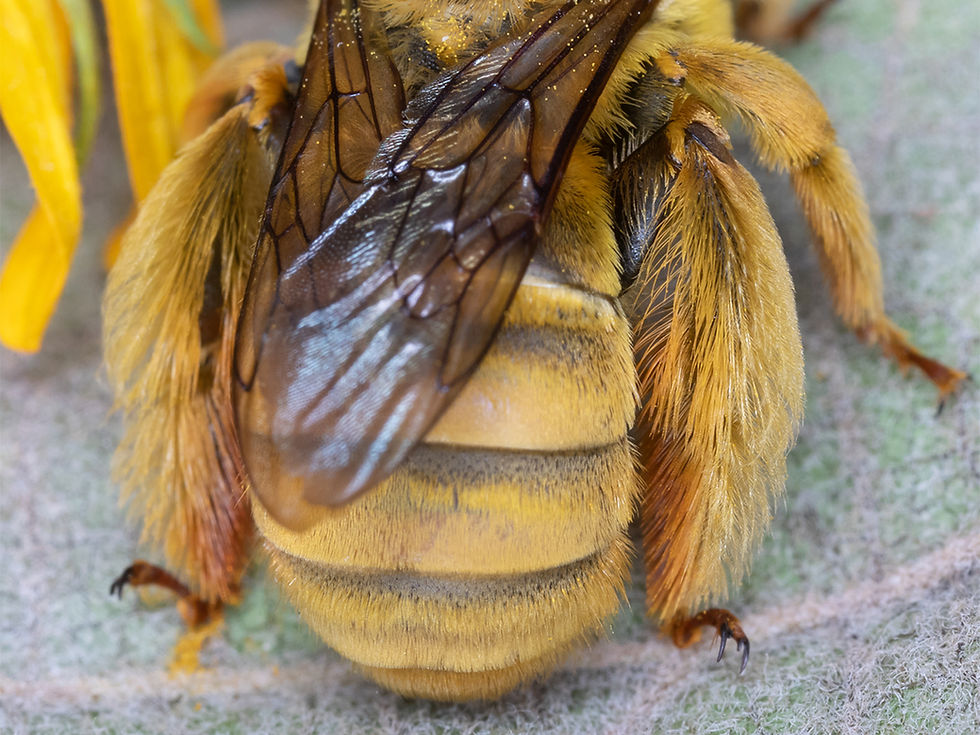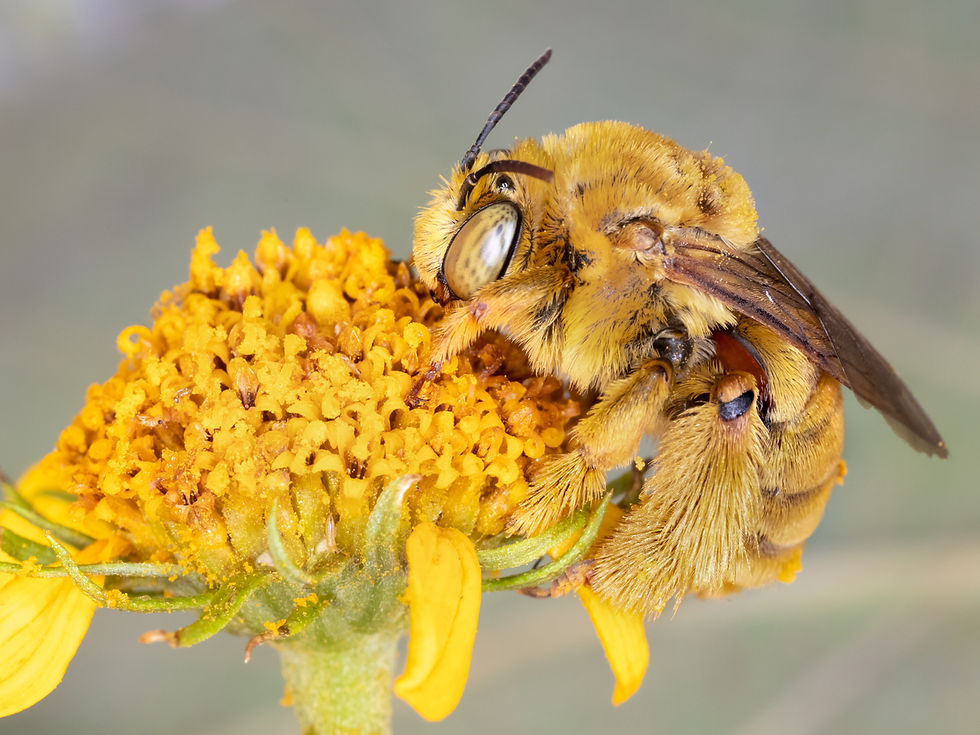SHARP-EATMAN
NATURE
PHOTOGRAPHY
How Wild Bees Carry Pollen
POLLINATION
Pollination occurs when a bee carries pollen from the anther of a flower to the stigma of a flower. Bees do not intentionally carry out pollination; it is the unintended result of the bee’s travels. Pollen clings to the branched and sticky hairs of the bee's body, and is rubbed off as the bee walks or flies from one blossom to another.
Bees carry pollen in order to transport it back to their nests. Pollen is stored in various forms, usually for feeding to the bees' young after they hatch. In most wild bee species, the females are responsible for carrying and storing pollen. Males of many species drink nectar from flowers, but lack attributes that allow them to transport pollen efficiently.
IDENTIFYING BEES BY HOW THEY POLLINATE
Female bees of varying species have evolved singular methods of transporting pollen. Female honey bees and bumble bees, for example, carry pollen in baskets called corbiculae. A corbicula is made up of hairs blended together to form a concave shape.
Most wild bees lack pollen baskets. Instead, many wild female bees have specialized leg hairs called scopae that are particularly long or sticky. Often, the hairs on bees' legs, bodies and faces have a slight electrostatic positive charge; negatively-charged pollen is thus attracted to the hairs.
As shown in the photo gallery below, particular families and species of bees can be recognized by the distinctive ways in which they carry pollen. Female Andrena mining bees, for example, are said to carry pollen "under their armpits" -- that is, stuffed up against the inside upper surfaces of their back legs.
Bees in the family Megachilidae, such as leafcutter, mason, resin and carder bees, transport pollen on long scopal hairs on their abdomens. This distinctive trait also aids in such bees' identification.
A few bee varieties lack visible attributes for carrying pollen. One is yellow-faced bees, also known as masked bees. These carry pollen internally, in a special organ designed for that purpose. Thus the bees lack the external hairs characteristic of most bees.
NOT ALL BEE SPECIES POLLINATE FLOWERS
Most bees nourish themselves and their young by sipping nectar or gathering pollen from flowers. A few bee varieties, known collectively as cuckoo bees, however, do not collect pollen and thus do not have hairy bodies or pollen-collecting features.
Cuckoo bees survive by raiding the nests of pollen-bearing bees, where the cuckoos deposit their eggs. When the cuckoo young merge, they devour the pollen stores left by the hosts for their own offspring. Sometimes the cuckoos kill off the hosts' young as well.
PHOTOGRAPHIC GALLERY OF POLLINATORS
Below is a gallery of photographs showing different types of bees and the specialized ways in which they have evolved in order to transport pollen.































Bees as a rule have a "furry" appearance. Hair on all parts of a bee's body serves to attract pollen. This female true long-horned bee (Melissodes trinodis) has particularly feathery, branched hairs on her hind legs that allow her to carry large pollen loads.

This is a common eastern bumblebee (Bombus impatiens), carrying orange pollen in corbiculae, or pollen baskets. The corbiculae are made of densely woven hairs on the bee's hind legs.

This is a Georgian mason bee (Osmia georgica). Mason, leafcutter, carder and resin bees, all members of the family Megachilidae, carry pollen on scopal hairs located on the undersides of the bees' abdomens.

Male bees lack special pollen-collecting hairs, but nonetheless may transport pollen inadvertently. This male Carlin's mining bee (Andrena carlini) has been sipping nectar from snow drops. The bee's positively-charged thorax hairs have attracted negatively-charged yellow snow drop pollen -- despite the fact that the bee is not gathering pollen intentionally. When the male bee flies to another snow drop blossom, the pollen may rub off and coincidentally pollinate it.

This female Say's cuckoo leafcutter has no pollen-carrying hairs on her legs or underside. This is because cuckoos rob pollen from the nests of other bees, rather than collecting it themselves.
COPYRIGHTS: This website's photos and text are protected by registered copyright. All photos are © 2014-2017 Paula Sharp & Ross Eatman, all rights reserved. To inquire about possible use of photos, see Permissions.
REFERENCES: For a comprehensive list of references used in compiling this guide, click here:
